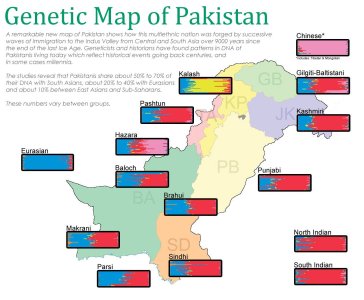RameezRambo_Fan
Tape Ball Regular
- Joined
- Jul 3, 2019
- Runs
- 338
The “Genetic Journey of Pakistan” illustrates how the genetic makeup of Pakistan’s various ethnic groups was forged by successive waves of immigration from Central Asia and South Asia since the end of the last Ice Age. Throughout its long ancient history, the Indus Valley has been known welcome different peoples, faiths and cultures. The Indus was a region that our early human ancestors encountered soon after they left Africa between 50,000 to 70,000 years ago. Evidence of these early humans can be found throughout Pakistan today at Soan, Riwat, Makli Hill, Bajaur and Sanghao. Approximately 9000 years ago they were among the world's first farmers and established cities such as Mehrgarh, which eventually expanded to represent the Harappan culture (Indus Valley Civilization) in 3000 BCE, rivaling the early city-states of Mesopotamia. Shortly after the fall of the Harappan civilization in 1500 BCE, a massive migration is said to have taken place from Eurasia to the Indus Valley, known today as the Aryan migration. This eventually led to the formation of the Vedic civilization by 1200 BCE. After 500 BCE, the Indus Valley would come under the influence of the Achaemenid Persians, Alexander’s Macedonian Empire, Greeks, Buddhists (Mauryans), Central Asians (Sycthians, White Huns), Mongols, Iranians, Arabs and Turks. It was through these various influences by which our nation would be forged into its multi ethnic society today. Pakistanis are divided genetically into 11 distinct groups: Baloch, Brahui, Burusho, Hazara, Kalash, Kashmiri, Makrani, Parsi, Pashton, Punjabi and Sindhi. Other groups are also being investigated at present such as the Kho (Chitrali), Seraiki and Baltis. The studies show that our ethnic groups share about 40% to 60% of their DNA with South Asians, about 40% to 60% with Eurasians and about 20% to 40% with East Asians, West Asians or Sub-Saharan Africans. These percentages vary between various ethnic groups and subgroups.
Population Structure Inferred from Microsatellite and Insertion/Deletion Polymorphisms. Representative estimate of population structure for Pakistan. The plot represents the highest-likelihood run among ten STRUCTURE runs with K = 7 clusters.
Source: http://journals.plos.org/plosgenetics/article?id=10.1371/journal.pgen.0020215

Population Structure Inferred from Microsatellite and Insertion/Deletion Polymorphisms. Representative estimate of population structure for Pakistan. The plot represents the highest-likelihood run among ten STRUCTURE runs with K = 7 clusters.
Source: http://journals.plos.org/plosgenetics/article?id=10.1371/journal.pgen.0020215






